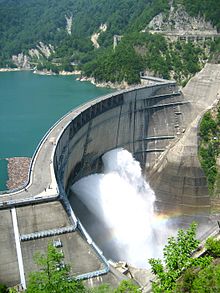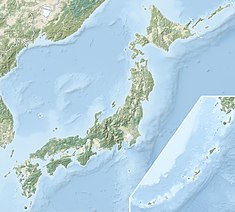Kurobe Dam
This article has multiple issues. Please help improve it or discuss these issues on the talk page. (Learn how and when to remove these messages)
|
| Kurobe dam | |
|---|---|
 View of Kurobe Dam, orifice floodgates discharging water | |
| Official name | 黒部ダム |
| Location | Toyama Prefecture |
| Coordinates | 36°33′59″N 137°39′41″E / 36.56639°N 137.66139°E |
| Purpose | Power, water supply |
| Status | Operational |
| Construction began | 1956 |
| Opening date | 1963 |
| Construction cost | ¥51.3 billion $142.5 million (1963) |
| Operator(s) | Kansai Electric Power Company |
| Dam and spillways | |
| Type of dam | Arch, variable-radius (dome) |
| Impounds | Kurobe River |
| Height | 186 m (610 ft) |
| Length | 492 m (1,614 ft) |
| Width (crest) | 8.1 m (27 ft) |
| Width (base) | 39.7 m (130 ft) |
| Dam volume | 1,582,845 m3 (2,070,283 cu yd) |
| Spillway type | Service, uncontrolled overflow |
| Spillway capacity | 906 m3/s (32,000 cu ft/s) |
| Reservoir | |
| Creates | Kurobe Lake |
| Total capacity | 199,285,175 m3 (161,563.121 acre⋅ft) |
| Catchment area | 188.5 km2 (72.8 sq mi) |
| Surface area | 3.49 km2 (1.35 sq mi) |
| Power Station | |
| Operator(s) | Kansai Electric Power Company (KEPCO) |
| Commission date | 1961-1973 |
| Type | Conventional |
| Turbines | 4 x Pelton-type |
| Installed capacity | 335 MW |
| Annual generation | 1 billion kWh |
| Website http://www.kurobe-dam.com/ | |
The Kurobe Dam (黒部ダム) or Kuroyon Dam (黒四ダム), is a variable-radius arch dam on the Kurobe River in Toyama Prefecture, Japan. It supports the 335 MW Kurobe No. 4 Hydropower Plant and is owned by Kansai Electric Power Company. At 186 metres (610 ft) in height, it is the tallest dam in Japan.[1] It was constructed between 1956 and 1963 at a cost of ¥51.3 billion yen. The project was a difficult engineering feat for the rapidly growing post–World War II Japan, and claimed the lives of 171 people.[2]
History

In 1951, the Kansai Electric Power Company was formed to provide electric power for the Kansai region of Japan. Shortly after their formation, the area suffered from drought which caused power rationing. The drought along with the rapid growth of post–World War II Japan pushed the company to increase their generating capacity. After a series of geological and hydrological studies of the Kurobe River and Gorge, it was announced in late 1955 that the Kurobe Dam would be constructed.[1]
In July 1956, construction on the dam began.[1] Problems quickly arose while transporting material to the construction site as only one small railway existed through the narrow gorge.[3] Kansai decided to construct the 5.4 kilometres (3.4 mi) Kanden Tunnel under Mount Tate that could bring supplies from Ōmachi eastward towards the construction site. The tunnel proved an arduous task as a large fracture zone in the rock was encountered which took seven months to repair. In September 1959, the first concrete for the dam was placed and by October of the next year, the reservoir had begun to fill.[1]
The Kurobe No. 4 power station was built completely underground to protect it from common avalanches in the gorge and also for nature conservation purposes. By January 1961, two of Kurobe No. 4's Pelton turbines had begun operation at an initial capacity of 154 MW. In August 1962, the third turbine was in operation and by June 1963, the dam was complete at a final cost of ¥ 51.3 billion ($142.5 million (1963)). In 1973, a fourth turbine was installed and became operational; bringing the power station's production capacity to 335 MW. The fourth turbine cost ¥ 1.4 billion yen ($5 million (1973)). The first two turbines were manufactured by Voith and the second two by Japan's Hitachi. The dam initiated the development of Japan's first 275kV transmission system as well which allowed the transfer of electricity over greater distances.[1] A total of 171 people died during the construction of the dam.[2]
Specifications

The Kurobe Dam is a 492 m (1,614 ft) long and 186 m (610 ft) high, with variable-radius (dome) arch dam. The dam is 39.7 m (130 ft) wide at its base, 8.1 m (27 ft) wide at its crest and contains 1,582,845 m3 (2,070,283 cu yd) of concrete. The dam is flanked and supported by two "wing" dams which form the abutments; the one on the left bank is 69 m (226 ft) long and the right is 56 m (184 ft). The dam withholds a reservoir with a capacity of 199,285,175 m3 (260,655,168 cu yd) of which 148,843,000 m3 (194,679,000 cu yd) is live (active or "useful") storage. The reservoir also has a catchment area of 188.5 km2 (72.8 sq mi) and surface area of 3.49 km2 (1.35 sq mi).[4] The dam's spillway is located on its crest and contains 10 11.5 m (38 ft) wide uncontrolled openings with a maximum discharge capacity of 906 m3/s (32,000 cu ft/s). Three other openings exist in the dam's orifice which consist of 1.5 m (4.9 ft) diameter pipes, two of which can discharge a maximum of 88 m3/s (3,100 cu ft/s) each and the third 44 m3/s (1,600 cu ft/s). The dam's crest elevation is 1,454 m (4,770 ft) above sea level while the reservoir's normal operating level is 1,448 m (4,751 ft) and low level is considered 1,338 m (4,390 ft).[5]
The dam's power station, Kurobe No. 4, is located underground and contains four generators which are powered by Pelton turbines for a total installed capacity of 335 MW and average annual generation of 1 billion kWh.[1][6] The power station is 22 m (72 ft) wide, 33 m (108 ft) high and 117 m (384 ft) long. The penstock serving water to the power station is 10,909.6 m (35,793 ft) long and utilizes a maximum effective hydraulic head of 545.5 m (1,790 ft) while transferring a maximum of 72 m3/s (2,500 cu ft/s) to the turbines. The plant's surge chamber is 145.6 m (478 ft) long and 5 m (16 ft) high.[5]
In popular culture
[6] A novel turned film, Kurobe no Taiyō (黒部の太陽; literally "The Sun of Kurobe"), starring Yujiro Ishihara (the late brother of Tokyo governor Shintaro Ishihara), recounts the drama of the project. The P.A.Works's mecha anime television series Kuromukuro is mainly settled in a UN research facility located around the lake, while the NHK television series Project X was also based on the dam's construction.[1]
Access
The Kurobe Dam is the most popular hydropower site in Japan[1] and, between late June and mid-October, water is released from its spillway for onlookers. The surrounding Kurobe Gorge is also popular as well and is accessible by the Tateyama Kurobe Alpine Route.
Start from Toyama Station which, from March 2015, is accessible by Hokuriku Shinkansen (trains Kagayaki or its slightly slower counterpart, Hakutaka) from Tokyo, Nagano, Kanazawa, and various other stations along the Hokuriku Shinkansen Line. Take the train from Dentetsu Toyama Station in Toyama to Tateyama Station (Toyama) by Toyama Chihō Railway Tateyama Line (65 minutes). (Note: Toyama Station is the main station with the shinkansen hub, while Dentetsu Toyama is the station next to the main station with local lines that go through the towns of Funahashi, Kamiichi, and Tateyama, to ultimately reach Tateyama Station (Toyama)). From Tateyama Station (Toyama), take the Tateyama Cable Car to Bijodaira Station (7 minutes). From there, the Tateyama Kurobe Alpine Route bus will take you to the 2450 m high Murodō Station (50 minutes).
From Murodō Station, visitors should take the Tateyama Tunnel Trolleybus (10 minutes), followed by the Tateyama Ropeway (7 minutes), and finally the Kurobe Cable Car (5 minutes). From the last stop, a 15-minute walk will take visitors to the spectacular dam. The whole trip from Toyama Station takes roughly four hours to complete one-way, and costs around 10,000 yen in transportation fees. Various accommodations are available in Murodo area as well as near Tateyama Station, for those too tired to make the trip back down into Toyama City.
See also
References
- ^ a b c d e f g h "Milestones:Kurobe River No. 4 Hydropower Plant, 1956-63". IEEE. Retrieved 4 October 2010.
- ^ a b "Kurobe-river hydropower plant" (PDF). Concrete Lab. The University of Tokyo. Retrieved 4 October 2010.
- ^ Oka, Takashi (November 1960). The New Japan. The Rotarian. p. 22. Retrieved 4 October 2010.
- ^ "黒部ダム (くろべ) [別名]黒四ダム(くろよん) Kurobe Dam" (in Japanese). ダム便覧 (Dam Handbook). Retrieved 4 October 2010.
- ^ a b "関西電力 黒部川第四発電所 (Kurobe Kansaidenryoku Fourth plant)" (in Japanese). Suiryoku.com. Retrieved 24 January 2015.
- ^ a b "Kurobe Q & A". KurobeDam. Retrieved 4 October 2010.

